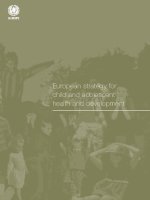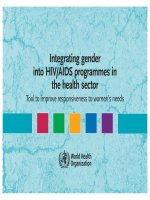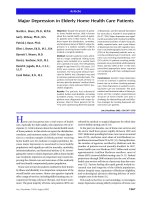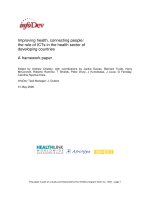Violence against Women: Health Sector Responses pptx
Bạn đang xem bản rút gọn của tài liệu. Xem và tải ngay bản đầy đủ của tài liệu tại đây (45.27 KB, 5 trang )
Prepared for the Gender and Development Group, PREM
1
Violence against Women: Health Sector Responses
National health policies, institutions and programs must pay greater attention to gender-
based violence (GBV) not only as a public health problem, but a key component of the
HIV/AIDS pandemic. We have some of the tools and knowledge to make a difference –
the same tools that have successfully been used to tackle other health problems. Violence
is often predictable and preventable.
Gro Harlem Brundtland, Director General, WHO, 2002
***
Violence against Women: The Hidden Health Burden
Violence against women exists to some degree in virtually all societies and all socio-economic and
cultural groups. Estimations on the prevalence of violence against women vary depending on the
type of violence in question. A study of 10 countries found that between 13 and 62 percent of
women have experienced physical violence by a partner over the course of their lifetime and
between 3 and 29 percent of women reported violence within the past year (Bott, Morrison and
Ellsberg, 2005).
A growing body of evidence documents the consequences of VAW for women’s health and well-
being, ranging from fatal outcomes such as homicide, suicide, and AIDS-related deaths to non-
fatal outcomes such as physical injuries, chronic pain syndrome, gastrointestinal disorders,
unintended pregnancies, pregnancy complications, and sexually-transmitted infections (STIs)
(Heise, Ellsberg, Gottemoeller, 1999).
Physical and sexual violence has consequences for women’s mental health, such as post-
traumatic stress syndrome, depression, anxiety, and low self-esteem, as well as behavioral
outcomes such as alcohol and drug abuse, sexual risk-taking, and a higher risk of subsequent
victimization. It has become increasingly clear that injuries represent only the tip of the iceberg
in terms of negative health effects, and that violence is more appropriately conceptualized as a
risk factor for health problems than as a health condition in itself. (See Box 1 for a summary of
the health consequences of intimate partner violence and sexual violence.)
Box 1.Health consequences of intimate partner violence and sexual violence by any perpetrator
Fatal outcomes Nonfatal outcomes
Physical injuries and chronic
conditions
Sexual and reproductive
sequelae
Psychological and behavioral
outcomes
Femicide
Suicide
AIDS-related
mortality
Maternal mortality
Fractures
Abdominal/thoracic injuries
Chronic pain syndromes
Fibromyalgia
Permanent disability
Gastrointestinal disorders
Irritable bowel syndrome
Lacerations and abrasions
Ocular damage
Burns
Ear Injuries
Gynecological disorders
Pelvic Inflammatory disease
Sexually-transmitted
infections, including HIV
Unwanted pregnancy
Pregnancy complications
Miscarriage / low birth weight
Sexual dysfunction
Unsafe abortion
Depression and anxiety
Eating and sleep disorders
Drug and alcohol abuse
Phobias and panel disorder
Poor self-esteem
Post-traumatic stress disorder
Psychosomatic disorders
Self harm
Unsafe sexual behavior
Sources: Adapted from Heise and Garcia Moreno, 2002 (pg 101); and Heise, Ellsberg and Gottemoeller, 1999 (pg 18).
Prepared for the Gender and Development Group, PREM
2
Health Services as an Opportunity
Women are waiting for someone to knock on their door: some of them have been waiting for many
years… They are grateful for the opportunity to unload their burden.
Nurse, El Salvador
I used to treat women with muscle spasms all the time, and I never asked them any questions. Then
I started to realize that many of these cases were due to violence.
Doctor, Nicaragua
Health services, and in particular, reproductive health programs provide a unique window of
opportunity to address the needs of abused women, since most women come into contact with
the health system at some point in their lives. Despite the compelling evidence that VAW is a
serious health risk for women, the health sector has lagged far behind other public sectors (for
example, criminal justice) in tackling the issue. Research indicates that although battered
women used primary and secondary health services more than non-abused women, a very small
percentage of them are identified as battered by health workers. Health providers are typically
reluctant to ask women about experiences of violence - either from fear of offending women or
reluctance to open a “Pandora’s box” of issues to which they will not know how to respond.
Providers often feel that they do not have the knowledge or skills to address VAW. They lack
knowledge both about national legislation on domestic violence and about local services to
which women might be referred. They often do not recognize VAW as a public health problem
and do not see it as part of their role to ask clients about violence or provide any kind of support
for victims.
Overlooking the health implications of violence against women is not just a missed opportunity.
Women sometimes disclose intimate partner violence, rape or sexual abuse to heath care
providers, and providers who respond by blaming the victim may inflict severe emotional
trauma. Providers who view violence as a social rather than a health issue may fail to provide
holistic care, to recognize women in danger, or to provide necessary, even life-saving care, such
as STI prophylaxis. Moreover, health systems that do not protect patient confidentiality may put
women at risk of additional violence from partners or other family members. Growing evidence
suggests that public health policies, institutions, and programs must pay more attention to
violence against women not only as a public health problem in and of itself, but also as a key
component of the HIV/AIDS pandemic.
Promising Practices
Use a systems approach to promote institutional change. Evidence suggests that without
system-wide reforms and support, single training sessions or even routine screening policies
rarely produce long-term changes in the quality of care for survivors of violence (Heise,
Ellsberg, and Gottemoeller, 1999). Instead, Heise et. al. suggest reforms throughout the
organization, including changes in procedures and systems, norms, policies and protocols,
infrastructure upgrades to ensure private consultations, creation of referral networks, and
strengthening the ability of staff to provide emergency assistance such as danger assessment,
safety planning, emotional support, STI prophylaxis, and emergency contraception.
Prepared for the Gender and Development Group, PREM
3
The International Planned Parenthood Federation, Western Hemisphere Region (IPPF/WHR)
carried out an initiative illustrating the “systems approach” in four member associations in Latin
America, namely: Profamilia (the Dominican Republic), INPPARES (Peru), and PLAFAM
(Venezuela), with some participation from BEMFAM (Brazil). Evaluations showed that the
initiative improved provider attitudes and practices; strengthened patient privacy and
confidentiality; increased detection of women who experienced physical and sexual abuse;
improved the overall quality of women’s health care; and benefited survivors through the
provision of specialized services such as legal aid, counseling and support groups (Guedes, Bott,
and Cuca, 2002).
Address provider attitudes. Health providers often share the same stigmatizing attidudes as the
population at large. These attitudes can be a serious barrier to improving the quality of care for
victims of abuse.
Address the underlying gender norms that support violence in the community. In order to
effectively promote sexual and reproductive health, it is necessary to create awareness at a
community level on the health effects of VAW and how VAW itself is rooted in unequal gender
relations.
Some of the specific practices that are being used with success include:
• Routine screening for violence by trained health care providers (also called routine
enquiry) – intake interviews of women attending clinics for regular check-ups enable
providers to better identify cases of physical and sexual abuse. This practice of routine
screening for victims of violence is increasingly considered the standard of care in
industrialized countries and is supported by researchers and advocates. However,
providers must be trained to respond to disclosures of violence appropriately, ensuring
privacy, confidentiality and support for the victims;
• Multi-sectoral collaboration – in which health care organizations join community-based
networks with other governmental and non-governmental institutions, such as legal aid,
criminal justice institutions, the police, women’s groups, social welfare education, and
social services. Evidence suggests that these networks enhance the range and quality of
services accessible to survivors, and help to ensure that women do not fall through the
cracks when they have to interact with several different institutions. For example, PAHO
has worked with 10 countries in Central America and the Andes to promote an integrated
health sector approach to violence against women through policies and legislation related
to violence, increasing access to services, and forging multi-sectoral networks at a
community level for violence prevention (Velzeboer et al., 2003).
• Coalitions for public health research and advocacy – which conduct research, build
research capacity, disseminate research findings and use research to advocate for policy
reforms. The South African Violence against women and Health Initiative convinced
two medical schools to include VAW in their curriculum, helped develop a one-week
Prepared for the Gender and Development Group, PREM
4
module on rape for medical students, and contributed to new national policies on the
issue;
• Community-level initiatives to reduce VAW – often components of HIV/AIDS
prevention or reproductive health programs – are well exemplified by the Stepping Stones
community “training packages” used in seven sub-Saharan countries, as well as the
Philippines. These programs aim at encouraging communities to question and rectify the
gender inequalities that lead to HIV/AIDS, VAW, and other health problems with
workshops, community-wide meetings, drama, and peer group discussions that include
changing male roles and conceptions of masculinity. Other programs, such as Men as
Partners, in South Africa (led by EngenderHealth), and Program H in Latin America
(led by Instituto Promundo), target specific groups such as men or young people; and
• Mass media “entertainment-education” (“edutainment”) - involves the use of radio and
television (including soap operas, audience participation programs and school-based
activities linked to the radio and television programs) to prevent VAW. The best known
is Sexto Sentido (The Sixth Sense), a weekly radio and TV series in which young people
grapple with sexuality, family violence, rape, and HIV/AIDS; Sexto Sentido is produced
in Nicaragua by the NGO Puntos de Encuentro. Another example is Soul City, conducted
by South Africa’s Institute for Health and Development Community. Evaluations of both
programs indicate that they have had a positive impact on knowledge and attitudes
regarding VAW.
Further Reading
Bott, Sarah, Andrew Morrison and Mary Ellsberg, Preventing and Responding to Violence
against women in Middle-and Low-Income Countries: A Global Review and Analysis, World
Bank Policy Research Working Paper 3618, the World Bank, Washington, DC, June, 2005
Guedes, Alessandra, Sarah Bott, and Yvette Cuca. 2002. “Integrating Systematic Screening for
Genderbased Violence into Sexual and Reproductive Health Services: Results of a Baseline
Study by the International Planned Parenthood Federation, Western Hemisphere Region.”
International Journal of Gynecology and Obstetrics 78: 557-563.
Heise, Lori, Mary Ellsberg, and Megan Gottemoeller. 1999. “Ending Violence Against Women,”
Population Reports, Volume XXVII, Number 4, Series L, Number 11. Available at:
Morrison, Andrew, Mary Ellsberg and Sarah Bott, Addressing Violence against women in the
Latin American and Caribbean Region: A Critical Review of Interventions, World Bank Policy
Research Working Paper 3438, the World Bank, Latin America and the Caribbean Region,
Poverty Sector Unit, October 2004
Prepared for the Gender and Development Group, PREM
5
Velzeboer, Marijke, Mary Ellsberg, Carmen Clavel Arcas and Claudia Garcia-Moreno, Violence
against Women: The Health Sector Responds, Pan American Health Organization and World
Health Organization, Washington, D.C., 2003
World Health Organization. World Report on Violence and Health. WHO: Geneva, 2002.









